Contractor Stories
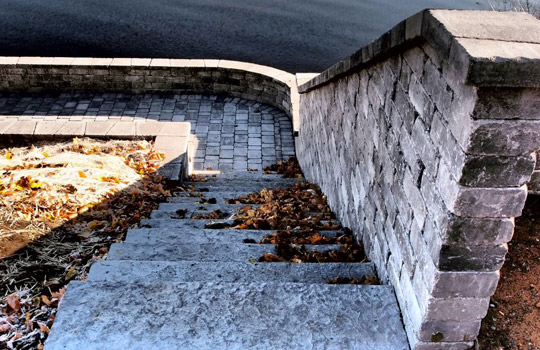
Keeping up with the clamp
Using a mechanical installer pushes Adam Buckpitt to find efficiencies throughout his field operation
By Tom HatlenBy taking a ton of classes, teaching classes, researching and talking to people, Adam Buckpitt created a very efficient operation … by most measures. Then a year ago he bought a mechanical installer clamp attachment, and that pushed his hand to find ways to do things even faster.
"As we became able to lay way more square feet of pavers in a day (up to 5,000), we've had to be able to keep up with everything else – edging, screeding the sand, cutting, compacting, sweeping sand – in order to be effective. We've had to fine tune everything.
"That has been a huge unexpected benefit from using the clamp. It got me to take a fresh look at how we were doing things and to rethink all of our work processes."
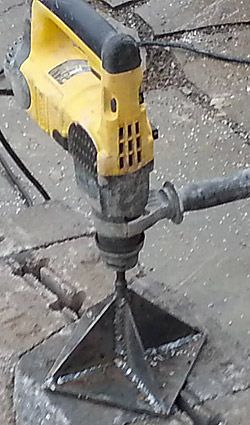
Adam created a mini-plate tamper bit for the hammer drill by cutting the end off a hammer drill bit and welding a 6" x 6" plate and 4 gussets on it. They use it on areas they can't get to with a walk-behind compactor like behind steps or beneath things protruding from the house like furnace venting or window air conditioners.
"It really does a good job of compacting. The pressure is applied by leaning your weight on the hammer drill. And there's a lot of frequency. It's a really slick little unit."
Watching "game tape"
One way Adam finds efficiencies is by sitting up at night watching "game tapes" like any good NFL coach. But his videos show his crews installing. They are taken by his father-in-law who tags along for maybe a 1/2 day 2 to 3 times a month.Adam became sold on videotaping a couple years ago from talking to Tom Gardocki who shoots a lot of video for his father Bill's company, Interstate Landscape, NH. Adam says his goal was to show prospects all the things that go into building a project so they would understand why prices are what they are. And video works great for that.
"But I found video was an even better tool for me to go back and look at how we can save time. I take the videos home and watch them 5, 6, 7 or 8 times. So the next time out we would tweak things, and it made a big difference in productivity."
Adam says when you're on a jobsite, you are in the moment and can't take in every little thing that's happening with 4 other people. You're just busy trying to keep everything moving.
Video greatly sped up the learning curve. For example, Adam concluded they spent too much time finessing the clamp. It works best if pallets are placed 90° from the laying face so the excavator can just spin to the pallet and back to the laying face with minimal clamp rotation in picking up the pavers or in placing them.
"It's 8 or 10 seconds every time you have to rotate. So if you rotate at the pallet, and rotate again at the laying face, you're adding 16 seconds per cycle. Little things like this easily add up to 30 extra seconds for each layer of pavers."
Doesn't sound like much? If there are 10 layers on a pallet and 20 pallets, 30 seconds per layer = 1 hour 40 minutes x 3 employees on the laying crew = 5 man-hours wasted.
"These are the kinds of things I got watching the video."
Adam's 5-man mechanical install process
Phase 1- 3 people install sand and screed to a point where they can begin laying pavers.
- 2 people install edging and stage pallets for the mechanical installer.
Phase 2
3 people form a laying crew (see video still images)
- 1 operates the excavator with the PaverMax Genius clamp attachment from Pave Tech.
- 1 crewman on the laying face guides the operator and taps pavers so alignment is straight and tight. Note: The crewman in the image is wearing Keen steel toe shoes that look like sneakers.
- The 3rd crewman stages more pallets with a skid steer. He aligns each layer of pavers and clears shrink wrapping, etc. so pavers are ready for the clamp.
- This crew finishes the screeding, pulling the 15' screeder by hand when the skid steer is moving pallets.
- They finish the edging, cut pavers, compact, sweep sand, whatever needs to be done.
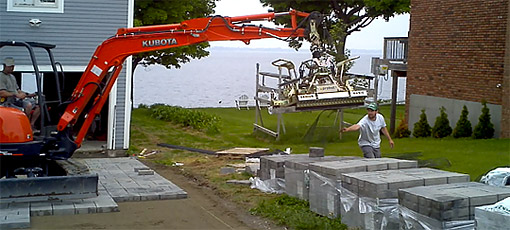
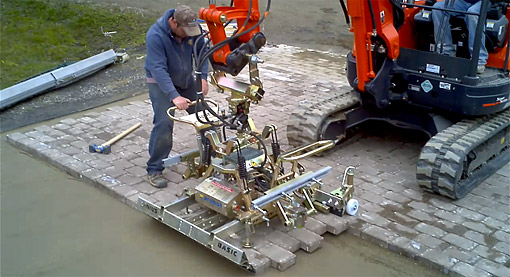
Screed with speed
Adam says he didn't need to watch video to know that they needed to find a way to screed faster. "We'd screed enough sand so the mechanical installer would run for 1 or 2 hours. Then it would have to stop and wait for us to screed some more because we couldn't keep up. You don't get any flow on a jobsite when everybody has to keep bouncing back and forth between tools. It really slowed us down."So they bought a Sand Max I screed system from Pave Tech. "It will expand up to 15' wide. We pull it backwards with our skid steer with 1 guy on each set of wheels for weight. It will screed as fast as you can back the skid steer up. That was a big leap forward, because if you can't keep up with the production of the clamp, it doesn't do you much good to have it."
PROFILE
Set In Stone Hardscapes
Swanton, VTFounded 2009
Adam Buckpitt, Owner
Customer base
80% residential20% commercial
Services
90% hardscape5% lighting
5% plowing
Largest project
$150,000Annual sales
2012 - $405,0002013 - $475,000 projected
Employees
4-6Mechanically install spikes
Like the Bahler Brothers (see our Feb/Mar 2013 issue) Adam uses a special hammer drill bit to pound in edging spikes for consistently fast production to the end of every day. In contrast, Adam says he's seen the speed of a crewman swinging a hammer vary a lot."The edging has to keep up like everything else. Installing spikes is one of those things nobody really liked to do until we got the hammer drill."
The laser is a huge time saver
A separate crew excavates and puts the base in place before the installation crew arrives. Adam says the excavation crew's greatest efficiency achievement has been switching to a grade laser. This allowed him to reduce the crew from 3 people to 2 people (Adam and a laborer). The crew now runs with 1 person hauling and 1 person excavating. They no longer need someone running strings and measuring. With 1 less paycheck, Adam recouped the $3,800 cost for the laser package in about a month."The dual grade laser has probably been the largest time saving tool that we've implemented in our company – bar none."
How it works on a straight driveway sloping down to a street:
- The laser sits on a tripod where the pavers meet the street.
- If the laser is 3.5' high, you set it to a spot 3.5' high at the garage floor as the grade.
- Affix the laser receiver to a spot on the excavator (or loader, etc.) arm that's 3.5' from the ground + the depth of the excavation, 1' for example.
- The laser is constantly spinning so it connects with the excavator receiver as it moves around the site.
- The excavator operator monitors the receiver on the machine's arm and gets an up arrow, down arrow or flashing green line telling him if he's on grade, too deep, or too shallow.
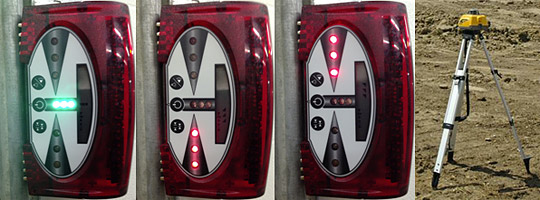
The laser level eliminated the need to run strings and reduced the size of the excavation crew to 1 less person. The laser on the tripod sends a signal to the receiver on the excavator arm that tells the operator if he's on grade, too deep, or too shallow.
Receiver photos courtesy Latec Instruments, Inc.
Laser on tripod photo courtesy mcesurvey.com
Laser on tripod photo courtesy mcesurvey.com
With the laser, excavation is faster and more accurate because the operator gets a constant grade readout, and doesn't need to stop work to do it. Operators grading with strings and tape measurers don't like to stop to check grade either – and that can be costly.
Adam says, "Over-digging is very costly because you have to get rid of that much more soil, and you have to bring in that much more stone and compact it – none of which you're getting paid to do."
For jobs over 2,000 sq ft
While the mechanical installer will lay 5,000 sq ft a day, it starts to provide a return on jobs over 2,000 sq ft. Even so, they sometimes use it on smaller jobs because it's easier on the crew. "But the labor savings isn't there because we could hand install 1,800 to 2,000 sq ft in a day."Adam says the mechanical installer accounts for probably 60% of their square footage last year though they only used it on 5 or 6 jobs. They use it enough to cover the payments, and plan to have the total $16,000 paid for by year 3. But they don't use it enough to see any real profit yet.
Their goal for 2012 was to become proficient at using it (which they've done) so they can be more competitive in bidding for larger jobs that come along. The more large jobs they do the more profitable the machine will be.
They've also positioned themselves for larger jobs by becoming their area's permeable paver experts. Adam estimates 30% to 40% of their work is already permeable pavers. As storm-water runoff regulations continue to expand there should be some sizeable permeable jobs in Set in Stone's future.
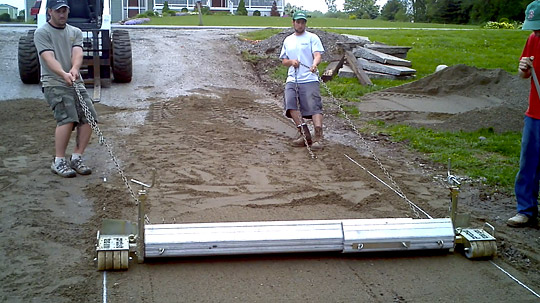
Set in Stone uses Pave Tech's SandMax 1 screeder to screed enough sand to keep up with the mechanical installer. The screeder adjusts from 7' to 15' wide and can be pulled by hand or by a loader.
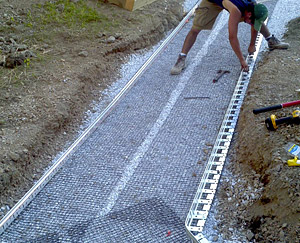
Adam estimates 30% to 40% of their work is permeable pavers. They use Permaloc’s integrated permeable pavement system that relies on special plates to bind the geo-grid to the edge restraints. Layers of stone and pavers will be placed over the geo-grid to securely anchor the system.
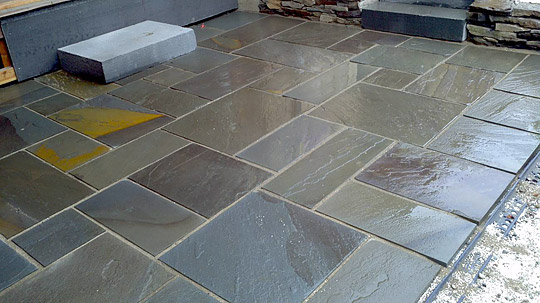
Natural stone is very popular in Vermont, so Adam usually has a 2-man crew devoted to installing stone. They dry-lay because the frequent freeze/thaw cracks mortar. Clients stay away from the uniform thickness "gauged" stone in favor of naturally textured stone that varies +/-1" in thickness. Irregular thickness slows production considerably with the foreman spending most of his time leveling and filling around each stone. Since laying time is slow, a 2nd crewmember is all that's needed to do other tasks, mostly hauling stones to the foreman.













